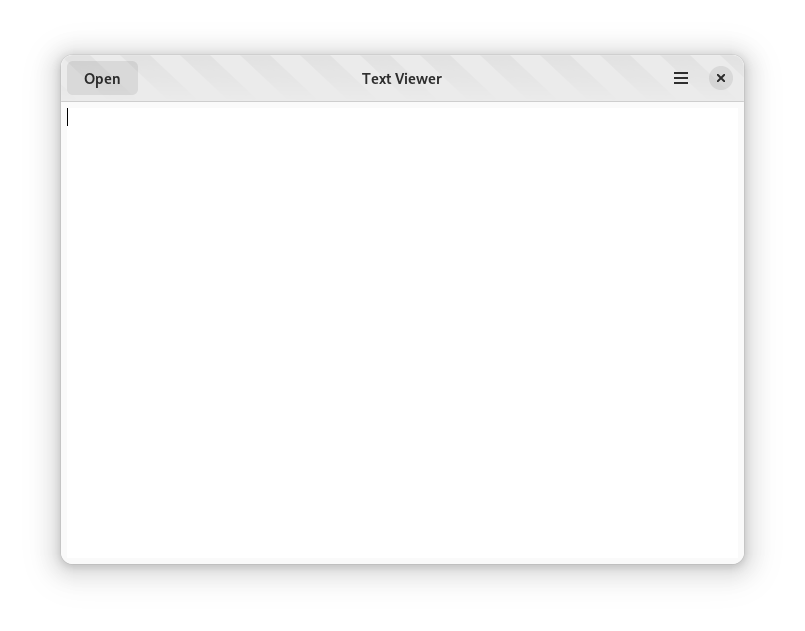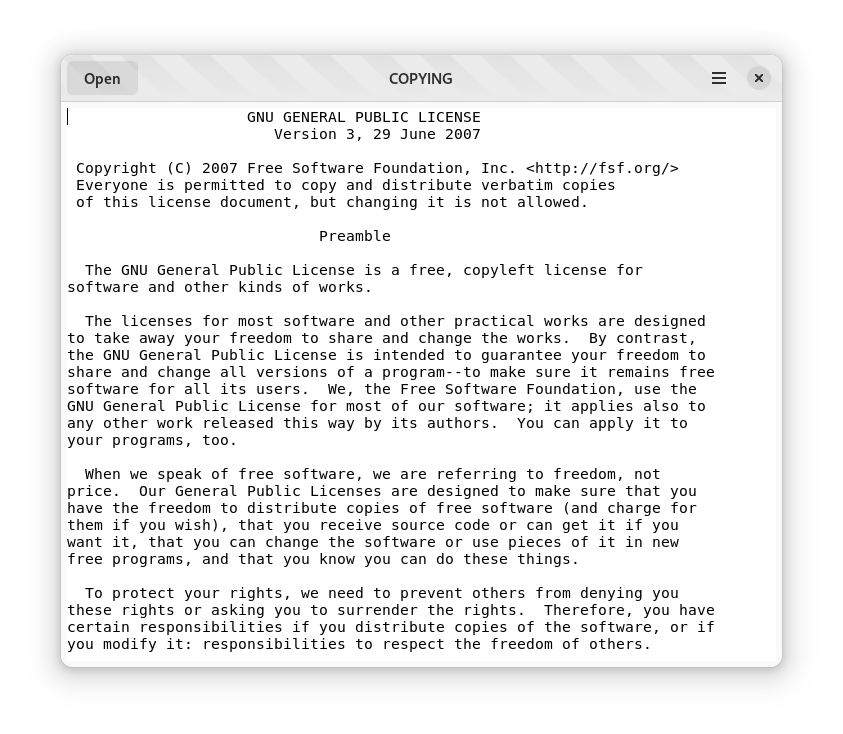Loading Content From A File
In this lesson you will learn how to ask the user to select a file, load the file’s contents, and then put those contents into the text area of our text viewer.

Add an “Open” button
In order to open a file, you need to let the user select it. You can follow these instructions to add a button to the window’s header bar that will open a file selection dialog.
Update the UI definition
- Open the
text-viewer-window.uifile - Find the object definition for the
Adw::HeaderBarwidget - Add an object definition for a
Gtk::Buttonas a child of the header bar, packing it at the leading edge of the window decoration using the start type:
<object class="AdwHeaderBar" id="header_bar">
<child type="start">
<object class="GtkButton" id="open_button">
<property name="label">Open</property>
<property name="action-name">win.open</property>
</object>
</child>
<child type="end">
<object class="GtkMenuButton">
<property name="primary">True</property>
<property name="icon-name">open-menu-symbolic</property>
<property name="tooltip-text" translatable="yes">Menu</property>
<property name="menu-model">primary_menu</property>
</object>
</child>- The button has the
open_buttonidentifier, so you can bind it in the window template. - The button also has an action-name property set to win.open; this action will be activated when the user presses the button.
Bind the template in your source code
- Open the
window.crfile - Add the
open_buttonwidget to theText::Viewer::Windowclass:
module Text::Viewer
@[Gtk::UiTemplate(
resource: "/com/example/TextViewer/text-viewer-window.ui",
children: {
"header_bar",
"main_text_view",
"open_button",
}
)]
class Window < Adw::ApplicationWindow
include Gtk::WidgetTemplate
@header_bar = Adw::HeaderBar
@main_text_view : Gtk::TextView
@open_button : Gtk::Button
def initialize
super()
@header_bar = Adw::HeaderBar.cast(template_child("header_bar"))
@main_text_view = Gtk::TextView.cast(template_child("main_text_view"))
@open_button = Gtk::Button.cast(template_child("open_button"))
end
end
endAdd the “Open” action
Add the open action to the Text::Viewer::Window class.
Once you add the open action to the window, you can address it as win.open:
- Create and add the action in the
Window's constructor:
module Text::Viewer
@[Gtk::UiTemplate(
resource: "/com/example/TextViewer/text-viewer-window.ui",
children: {
"header_bar",
"main_text_view",
"open_button",
}
)]
class Window < Adw::ApplicationWindow
include Gtk::WidgetTemplate
@header_bar = Adw::HeaderBar
@main_text_view : Gtk::TextView
@open_button : Gtk::Button
def initialize
super()
@header_bar = Adw::HeaderBar.cast(template_child("header_bar"))
@main_text_view = Gtk::TextView.cast(template_child("main_text_view"))
@open_button = Gtk::Button.cast(template_child("open_button"))
open_action = Gio::SimpleAction.new("open", nil)
open_action.activate_signal.connect do
self.open_file_dialog
end
self.add_action open_action
end
end
end- Open the
text-viewer.crsource file and find the class constructor - Add Ctrl + O as the accelerator shortcut for the
win.openaction
#...
class App < Adw::Application
def initialize
#...
self.set_accels_for_action("app.quit", {"<primary>q"})
self.set_accels_for_action("win.open", {"<Ctrl>o"})
#...
end
#...Select a file
Now that you have added action, you must define the function that will be called when the action is activated.
- Create an
open_file_dialogmethod inWindowinwindow.cr, and inside it, create aGtk::FileChooserNativeobject, which will present a file selection dialog to the user
#...
private def open_file_dialog
filechooser = Gtk::FileChooserNative.new("Open File", nil, Gtk::FileChooserAction::Open, "_Open", "_Cancel")
filechooser.transient_for = self
filechooser.show
end- When the filechooser emits the
responsesignal, the following code in the lambda gets executed. This happens once the user has selected the file and closed the dialog, or simply closed the dialog without selecting a file:
#...
private def open_file_dialog
filechooser = Gtk::FileChooserNative.new("Open File", nil, Gtk::FileChooserAction::Open, "_Open", "_Cancel")
filechooser.transient_for = self
filechooser.response_signal.connect do |response|
# If the user selected a file...
if Gtk::ResponseType.from_value(response) == Gtk::ResponseType::Accept
# ... retrieve the location from the dialog and open it
self.open_file (filechooser.file);
end
end
filechooser.show
endRead & Show the contents of a file
Instead of relying on Gio to read the file, you will use Crystal's IO operations. In the Window class in the window.cr file, create the following method:
#...
private def open_file(file : Gio::File?)
return if file.nil?
file_path = file.not_nil!.path.not_nil!
File.open(file_path) do |file_io|
# Retrieve the `Gtk::TextBuffer` instance that stores the
# text displayed by the `Gtk::TextView` widget
buffer = @main_text_view.buffer
# Set the text using the contents of the file
buffer.text = file_io.gets_to_end
# Reposition the cursor so it's at the start of the text
buffer.place_cursor(buffer.start_iter)
end
endUpdate the title of the window
Since the application now is showing the contents of a specific file, you should ensure that the user interface reflects this new state. One way to do this is to update the title of the window with the name of the file.
Since the name of the file uses the raw encoding for files provided by the operating system, we need to query the file for its display name.
- Modify the
open_filemethod to extract the file name from the path - Set the
titleof the window to the file name
#...
private def open_file(file : Gio::File?)
return if file.nil?
file_path = file.not_nil!.path.not_nil!
File.open(file_path) do |file_io|
self.title = File.basename(file_path, File.extname(file_path))
# Retrieve the `Gtk::TextBuffer` instance that stores the
# text displayed by the `Gtk::TextView` widget
buffer = @main_text_view.buffer
# Set the text using the contents of the file
buffer.text = file_io.gets_to_end
# Reposition the cursor so it's at the start of the text
buffer.place_cursor(buffer.start_iter)
end
endAdd the “Open” shortcut to the Keyboard Shortcuts help
The Keyboard Shortcuts help dialog is part of the template. GTK automatically handles its creation and the action that presents it to the user.
- Find the
help-overlay.uifile in the sources directory - Find the
GtkShortcutsGroupdefinition - Add a new
GtkShortcutsShortcutdefinition for the win.open action in the shortcuts group
<object class="GtkShortcutsGroup">
<property name="title" translatable="yes" context="shortcut window">General</property>
<child>
<object class="GtkShortcutsShortcut">
<property name="title" translatable="yes" context="shortcut window">Open</property>
<property name="action-name">win.open</property>
</object>
</child>You should now be able to run the application, press the Open button or Ctrl + O, and select a text file in your system. For instance, you can navigate to the text viewer project directory, and select the COPYING file in the sources:
